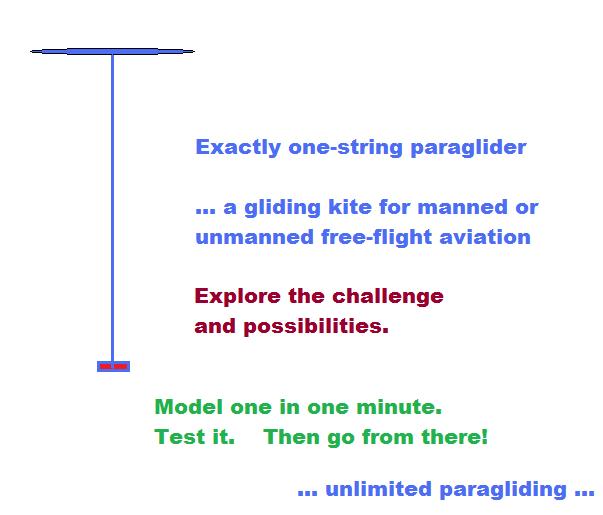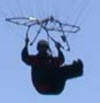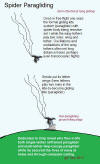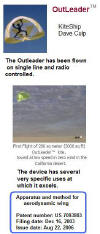|
LIFT
Dec. 2011, Page
6
...grows during month from your sent lifts |
Introduction:
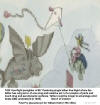 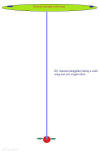
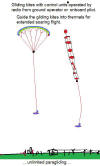 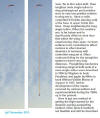  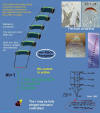  This topic for discussion is about one certain category of
gliding kites (paragliders).
Let kite be an assembly of wing parts, tether parts, and resistive
parts. When such kite is with the r freely falling in an atmosphere of a planet, then almost always a gliding kite (paraglider) will result as the resistive parts falling will set up a tension (being coupled to the dynamics of the elements of the wing set w that will allow the kiting principle to occur for the full arrangement of wing parts. As paragliders are members of the family hang gliders, then this topic is a hang gliding topic as well as a paragliding topic. Readers are invited to discuss the possibilities of a paraglider having exactly one tether from the wing bridle point to the bridle point of the resistive set. It is invited to distinguish two branches of such systems of this topic.
All are invited to send discussion notes on the topic described. Some teasing leading questions and some clarifications:
|
|
There is evidence of a
spectacularly wide opportunity; we in this forum over time may play a part
in unfolding that opportunity. Have fun doing so; but also play your
technical best, and your highest imagination.
|
|
The one line is very distinct from the SOL "One-Liner" that has many more
than one line to the wing set; in case of SOL's "ONE" there is also one
member in the wing set. But the one line of this topic may have a wing set
of more than one wing, say in a cluster or ladder or tree of wings, but
just one line to the resistive set (pilot and harness is option when done
safely). Adding to topic: Consider the one line being a conduit for more than tension; consider electrical conductive tether. See what might be done with electrical signals for solutions of the #t=1 manned gliding kite (paraglider for paragliding). |
|
A step from the prior note: Offer things to do with electricity sent from
wing set of the gliding kite (paraglider wing set part) to the resistive
set (perhaps pilot, harness, instruments, etc.) through the single-line
#t-1. I'll start: Use electricity perhaps made by the surfaces of the wing
set w to warm the pilot while he or she soars into cold airs. What else?
Or/and: Post on topic with other aspects of the #t=1 paraglider. There are many aspects, I trust. Then be a part of developing the aspects. See you tomorrow or so. |
|
Electricity may be brought down from the wing and stored in the payload;
some of that electricity may be used to drive servos that alter
aerodynamic control devices in the wing set. Also, some of the electricity
could be used to control the aerodynamic control devices that could be
placed in the payload to alter the lift and drag and direction of
deflection of the payload or resistive set r. Such garden of opportunity
might serve extreme cross-country soaring of the gliding-kite system, that
is, the paraglider. While there is no doubt much to go on the electrical bit, I open the potential of having the tether be a conduit for pressurized air for untold purposes in the paraglider. Others are invited on this aspect or any other aspect of the #t=1 paraglider. Include your drawings, if you will, to illustrate your ideas, projects, experiments on the topic. |
|
A fascinating diversion from the conventional trend to ever thinner
"tethers" (suspension lines in laymen's terms). ~BP |
| Well it was good enough for Mary Poppins, though her glider definitely had a rigid primary structure she did take off and land safely in zero wind conditions. ~RW |
| Well, I was thinking to this experiment, it worked out in terms of gathered energy, maybe too much energy: it melted the cable.... some 3500 volts difference ignited plasma in air trapped in the line. Hope similar failures would never happen in PG lines. http://www.phy6.org/Education/wtether.html ~Vidimart |
|
=To Rod B:
Topic is about exploring, not consensus seeking. Try + adds. =To Vidimart: Your Space tether is interesting. I offer for topic: Electricity made via wing-incorporated solar-energy conversion fabric, RATs, and piezoelectrics. =All: I add today: Possible control by RC of wing set and payload set of #t=1 paragliders. =And: Consider pilot in payload generating electricity by body motions; send the electricity to various parts of the PG for various uses. And: The topic game allows the one tether out of payload, but splitting may occur above shaping and bridling. =Note: Set w is open for any wing known to aviation singly or in multiples. Drawings are welcome. Photos too of your single-tether paraglider projects. |
| What use would you have for pilot generated electricity 3000 m up in the air? And does "generating electricity by body motions" mean that I would have to attach some hamster wheel to my risers and run while flying? Or just flap my arms like mad with dynamos strapped under my armpits? ~~Monos |
|
From the kite bridle of the first wing of w: drop the one tether to the main payload where one might find a system's human pilot or a robot control unit. The bridle integration point would be the top terminus of the main rising single tether of the #t=1 paraglider. In-fight extending the main long single tether: let payload drop further away from the w. Or let part of the payload drop lower temporarily or permanently. One might mine the drop to generate electricity; Bob Stuart mentions that some building elevators employ regenerative elevator systems. Let-down pilot might be a way to deliver personnel to ground points while still soaring the paraglider. Glad to see the best anyone has toward the topic. |
|
Notice options for the one tether rising from payload: short, long, very
long ; distinct opportunities for PG universe for each length realm;
explore each.
LLW: long live Woglom |
| Happy to predict that a very long single-tethered paraglider will set extreme world records for cross-country travel with humans aboard. Controls of the unpowered paraglider will effect attitudes in the upper wing and attitudes in the lower resistive subassembly. The upper wing set will be in an air stream quite different from the stream of the resistive or payload set. Dale C. Kramer has for years been mapping out flights using detailed weather reports. No fuel for lift. This is a proud future for machine paraglider. Clearance for the record flights will be specially given by airspace governance, as the long line will be obstacle and the airspace used will be that which is frequently by commercial aircraft. As the physics allow cross-continent paraglider flight, it will be permitted at least once. Moderator Team: May I attach drawings and documents illustrating these matters? |
| Monos offers something close to a launch method: Tie to airliner. But to be in free-flight, separation from the airliner would be needed. This is a form of launch by help from a powered aircraft. Other launch methods are invited to be explored. |
|
Joe, I just wonder why you
started this discussion on a paragliding forum? As I understand it, your
amazing concept is far from the machine described in Wiki as a
'paraglider', or as used on my local hills. Imagine the chaos if half a
dozen of us tried to soar a site with a single line that stretched so high
it would need airspace restrictions lifted? From what you say the 'kite'
will be virtually in space. Let alone the problems of launching such a
baby, as Pete said. Have you really thought this through properly.
~BM Partial response: The reason the topic was started on the paragliding forum was because the topic is solidly about a paragliding matter. That the topic is focused on a corner of the paragliding universe will permit some focus on a corner, not the whole, of paragliding. The too-narrow definitions of paraglider in some places does not rule this topic discussion; rather, the full mechanical and historical definition of paraglider is being the guide for this discussion; we would be limited by those narrow definitions. Your scenario of traffic and possible challenges of having many systems that have very long single tether is very much on topic. That is an important concern you introduce. You are encouraged to advance some attention on that matter. Communicating airspace use would be important for all other aircraft in the concerned environment. Launching will be solidly part of this discussion. I will put up some launching ideas. Others are invited to look at the launching and landing of paragliders having one tether from wing set bridle point to the brindle point of the resistive set. ~JpF |
|
RB offers the question about the places humans may
sit or be placed in the paragliders of this topic.
Partial response: There are no restrictions about where humans may sit or be placed. Depending on mission and size of the system, humans may be in any or all places in the system. That is, some humans might remain in the resistive set; some might be on the tether set which in this case is the one tether between r bridle point and the bridle point of w. Humans may move about the system; the humans might go up or down the outside of the main tether or the inside of the tether, if the tether is hollow. Humans might be on one or several of the wing-set wings. Sleeping quarters may be equipped with items to meet long stays in the air. Humans may be part of the control system and take shifts while others play or sleep aboard, especially during transcontinental flights. JpF |
|
RodB, about your
question on sit place?
Response: Crew placement options: in r or mid t or in w; some in each part or all in w, etc., mission dependent. Risks in r differ from those in w. JpF |
|
Sport paragliding may generally avail itself of any
wing, not just fully-limp canopy wings; in the option set for w there are
wings that tend to better fit one mission over another mission.
Want clarity :: key to getting goals; the tether in this topic may be any length from very short to very long; a wide adventure is open. Trans-continent #t=1: crew enough to allow sleep periods. |
|
JB
wondered about twirling of the r during flight.
Response: There are ways to fly pilot pod winged for orienting and avoiding twirling. Active flying for the resistive set r is a realm inviting design exploration. Indeed, when the r is in a different strata of the air, there is control opportunity for r by controlling its own deflections; indeed r is a wing itself with a potential to be controlled for changes in its lift and drag. Controlling the attitude and motions of r may increase or decrease the tension in the main tether and thus the interplay with w occurs. Such actions will play a part in transcontinental systems of the type we are discussing. But further, deliberate twirling or autorotation may be just the desired dynamic for all or part of r in a flight system. Pitch control of rotating blades may be part of some solutions here; recall, humans may be beaded in the r or beaded on the main tether or be situated in w elements. Rapid deliberate autorotation of the r might be with g forces or dizzy-causing motions that are not fit for humans. All these aspects invite creative exploration. Continue sending in your discussion notes on this topic. |
|
http://www.energykitesystems.net/WPGA/images/GlidingKites/lengthenline.jpg
|
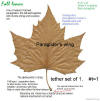 Some
gliding leaves are not paragliders. Some gliding leaves with stems are not
paragliders. But some falling leaves are paragliders. The image here
over speaks and an adjustment is needed; some of the fall leaves remain
non-paraglider gliders; but some get into the paraglider mode; e. g.
curled or torn leaves or leaves with long-enough stem parts get into
paraglider mode. Some
gliding leaves are not paragliders. Some gliding leaves with stems are not
paragliders. But some falling leaves are paragliders. The image here
over speaks and an adjustment is needed; some of the fall leaves remain
non-paraglider gliders; but some get into the paraglider mode; e. g.
curled or torn leaves or leaves with long-enough stem parts get into
paraglider mode.
A stiff short tether on a fall leaf which leaf is stiff and flat and large will be a non-paraglider glider. But if the stem is long enough and massive enough and the leaf form is small enough or curled enough or broken enough, then often a paraglider will result; such will be part of this topic's discussion. Nature provides billions of such paragliders from deciduous trees each year. |
|
Peter Jongejan posts on topic: There surely exists a paraglider with a one-line connection between the pilot and the glider: The Cage! http://www.aspic.org/fr/modeles.php
To PeterJ:
For sure: Yes, The Cage is a short tether example on topic, as are
the short-tether stiffened wings; and more to come with boned PG, stuffed
PGs, solid PGs; and the dynamic-soaring ULL single-tether systems
(Ultra-Long-Line). The Cage "control unit" could be replaced with a KSU or
KCU on the ULL PG for exploring trans-continental flight. An activity
sector just for La Cage welcomes
further input. |
|
|



